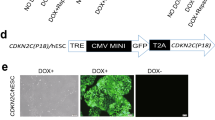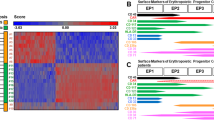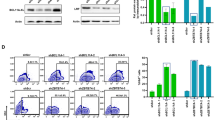Abstract
Erythroleukemia induced by Friend Murine Leukemia Virus (F-MuLV) serves as a powerful tool for the study of multistage carcinogenesis and hematological malignancies in mice. Fli-1, a proto-oncogene and member of the Ets family, is activated through viral integration in F-MuLV-induced erythroleukemia, and is the most critical event in the induction of this disease. Fli-1 aberrant regulation is also observed in human malignancies, including Ewing's sarcoma, which is often linked to expression of the EWS/Fli-1 fusion oncoprotein. Here we examined the effects of Fli-1 inhibition to further elucidate its role in these pathological occurrences. The constitutive suppression of Fli-1, through RNA interference (RNAi), inhibits growth and induces death in F-MuLV-induced erythroleukemia cells. Expression of a dominant negative protein Engrailed (En)/Fli-1 reduces proliferation of EWS/Fli-1-transformed NIH-3T3 cells, and both F-MuLV-induced and human erythroleukemia cells. F-MuLV-induced erythroleukemia cells also display increased apoptosis, associated with reduced expression of bcl-2, a known fli-1 target gene. Introduction of En/Fli-1 into an F-MuLV-infected erythroblastic cell line induces differentiation, as shown by increased α-globin expression. These results suggest, for the first time, an essential role for continuous Fli-1 overexpression in the maintenance and survival of the malignant phenotype in murine and human erythroleukemias.
This is a preview of subscription content, access via your institution
Access options
Subscribe to this journal
Receive 12 print issues and online access
$259.00 per year
only $21.58 per issue
Buy this article
- Purchase on Springer Link
- Instant access to full article PDF
Prices may be subject to local taxes which are calculated during checkout






Similar content being viewed by others
References
Oikawa T, Yamada T . Molecular biology of the Ets family of transcription factors. Gene 2003; 303: 11–34.
Ben-David Y, Giddens EB, Bernstein A . Identification and mapping of a common proviral integration site Fli-1 in erythroleukemia cells induced by Friend murine leukemia virus. Proc Natl Acad Sci USA 1990; 87: 1332–1336.
Klemsz MJ, Maki RAPT, Moore J, Hromas R . Characterization of the ets oncogene family member, fli-1. J Biol Chem 1994; 268: 5769–5773.
Lee CR, Cervi D, Truong AH, Li YJ, Sarkar A, Ben David Y . Friend virus-induced erythroleukemias: a unique and well-defined mouse model for the development of leukemia. Anticancer Res 2003; 23: 2159–2166.
Tamir A, Howard J, Higgins RR, Li YJ, Berger L, Zacksenhaus E et al. Fli-1, an ets-related transcription factor, regulates erythropoietin-induced erythroid proliferation and differentiation: evidence for direct transcriptional repression of the Rb gene during differentiation. Mol Cell Biol 1999; 19: 4452–4464.
Lesault I, Quang CT, Frampton J, Ghysdael J . Direct regulation of BCL-2 by FLI-1 is involved in the survival of FLI-1-transformed erythroblasts. EMBO J 2002; 21: 694–703.
Truong AH, Cervi D, Lee J, Ben David Y . Direct transcriptional regulation of MDM2 by Fli-1. Oncogene 2005; 24: 962–969.
Pereira R, Quang CT, Lesault I, Dolznig H, Beug H, Ghysdael J . FLI-1 inhibits differentiation and induces proliferation of primary erythroblasts. Oncogene 1999; 18: 1597–1608.
Zochodne B, Truong AH, Stetler K, Higgins RR, Howard J, Dumont D et al. Epo regulates erythroid proliferation and differentiation through distinct signaling pathways: implication for erythropoiesis and Friend virus-induced erythroleukemia. Oncogene 2000; 19: 2296–2304.
Delattre O, Zucman J, Plougastel B, Desmaze C, Melot T, Peter M et al. Gene fusion with an ETS DNA-binding domain caused by chromosome translocation in human tumours. Nature 1992; 359: 162–165.
May WA, Gishizky ML, Lessnick SL, Lunsford LB, Lewis BC, Delattre O et al. Ewing sarcoma 11;22 translocation produces a chimeric transcription factor that requires the DNA-binding domain encoded by FLI1 for transformation. Proc Natl Acad Sci USA 1993; 90: 5752–5756.
Mhawech-Fauceglia P, Herrmann F, Penetrante R, Beck A, Sait S, Block AM et al. Diagnostic utility of FLI-1 monoclonal antibody and dual-color, break-apart probe fluorescence in situ (FISH) analysis in Ewing's sarcoma/primitive neuroectodermal tumor (EWS/PNET). A comparative study with CD99 and FLI-1 polyclonal antibodies. Histopathology 2006; 49: 569–575.
Cui JW, Li YJ, Sarkar A, Brown J, Tan YH, Premyslova M et al. Retroviral insertional activation of the Fli-3 locus in erythroleukemias encoding a cluster of microRNAs that convert Epo-induced differentiation to proliferation. Blood 2007; 110: 2631–2640.
Funk WD, Wright WE . Cyclic amplification and selection of targets for multicomponent complexes: myogenin interacts with factors recognizing binding sites for basic helix-loop-helix, nuclear factor 1, myocyte-specific enhancer-binding factor 2, and COMP1 factor. Proc Natl Acad Sci USA 1992; 89: 9484–9488.
Howard JC, Berger L, Bani MR, Hawley R, Ben-David Y . Activation of the erythropoietin gene in the majority of F-MuLV-induced erythroleukemias results in growth factor independence and enhanced tumorigenicity. Oncogene 1996; 12: 1405–1415.
Wang N, Kudryavtseva E, Ch'en IL, McCormick J, Sugihara TM, Ruiz R et al. Expression of an engrailed-LMO4 fusion protein in mammary epithelial cells inhibits mammary gland development in mice. Oncogene 2004; 23: 1507–1513.
Markel H, Chandler J, Werr W . Translational fusions with the engrailed repressor domain efficiently convert plant transcription factors into dominant-negative functions. Nucleic Acids Res 2002; 30: 4709–4719.
Montross WT, Ji H, McCrea PD . A beta-catenin/engrailed chimera selectively suppresses Wnt signaling. J Cell Sci 2000; 113: 1759–1770.
Lyon JJ, Watson RJ . Interference of Myb transactivation activity by a conditional dominant negative protein: functional interference in a cytotoxic T-cell line results in G1 arrest. Gene 1996; 182: 123–128.
Watson DK, Smyth FE, Thompson DM, Cheng JQ, Testa JR, Papas TS et al. The ERGB/fli-1 gene: isolation and characterization of a new member of the family of human ETS transcription factors. Cell Growth Differ 1992; 3: 705–713.
Rao VN, Ohno T, Prasad DD, Bhattacharya G, Reddy ES . Analysis of the DNA-binding and transcriptional activation functions of human Fli-1 protein. Oncogene 1993; 8: 2167–2173.
Zhang L, Lemarchandel V, Romeo P-H, Ben-David Y, Bernstein A . The Fli-1 proto-oncogene involved in erythroleukemia and Ewing's sarcoma, encodes a transcriptional activator with DNA-binding specificities distinct from other Ets family members. Oncogene 1993; 8: 1621–1630.
Ben-David Y, Giddens EG, Letwin K, Bernstein A . Erythroleukemia induction by Friend murine leukemia virus: insertional activation of a new member of the ets gene family, Fli-1, closely linked to c-ets-1. Genes Dev 1991; 5: 908–918.
Howard JC, Li Q, Chu W, Zochodne B, Kapoor M, Ung Y et al. Bcl-2 expression in F-MuLV-induced erythroleukemias: a role for the anti-apoptotic action of Bcl-2 during tumor progression. Oncogene 2001; 20: 2291–2300.
Ben-David Y, Bernstein A . Friend virus-induced erythroleukemia and the multistage nature of cancer. Cell 1991; 66: 831–834.
Zhang L, Eddy A, Teng T, Fritzler M, Kluppel M, Melet F et al. An immunological renal disease in transgenic mice that overexpress Fli-1, a member of the ets family of transcription. Mol Cell Biol 1995; 15: 6961–6970.
Hart A, Melet F, Grossfeld P, Chien K, Jones C, Tunnacliffe A et al. Fli-1 is required for murine vascular and megakaryocytic development and is hemizygously deleted in patients with thrombocytopenia. Immunity 2000; 13: 167–177.
Spyropoulos DD, Pharr PN, Lavenburg KR, Jackers P, Papas TS, Ogawa M et al. Hemorrhage, impaired hematopoiesis, and lethality in mouse embryos carrying a targeted disruption of the Fli1 transcription factor. Mol Cell Biol 2000; 20: 5643–5652.
Melet F, Motro B, Rossi DJ, Zhang L, Bernstein A . Generation of a novel Fli-1 protein by gene targeting leads to a defect in thymus development and a delay in friend virus-induced erythroleukemia. Mol Cell Biol 1996; 16: 2708–2715.
May WA, Lessnick SL, Braun BS, Klemsz M, Lewis BC, Lunsford LB et al. The Ewing's sarcoma EWS/FLI-1 fusion gene encodes a more potent transcriptional activator and is a more powerful transforming gene than FLI-1. Mol Cell Biol 1993; 13: 7393–7398.
May WA, Arvand A, Thompson AD, Braun BS, Wright M, Denny CT . EWS/FLI1-induced manic fringe renders NIH 3T3 cells tumorigenic. Nat Genet 1997; 17: 495–497.
Dohjima T, Lee NS, Li H, Ohno T, Rossi JJ . Small interfering RNAs expressed from a Pol III promoter suppress the EWS/Fli-1 transcript in an Ewing sarcoma cell line. Mol Ther 2003; 7: 811–816.
Torchia EC, Boyd K, Rehg JE, Qu C, Baker SJ . EWS/FLI-1 induces rapid onset of myeloid/erythroid leukemia in mice. Mol Cell Biol 2007; 27: 7918–7934.
Yi H, Fujimura Y, Ouchida M, Prasad DD, Rao VN, Reddy ES . Inhibition of apoptosis by normal and aberrant Fli-1 and erg proteins involved in human solid tumors and leukemias. Oncogene 1997; 14: 1259–1268.
Goltzene F, Skalski M, Wolff CM, Meyer D, Mager-Heckel AM, Darribere T et al. Heterotopic expression of the Xl-Fli transcription factor during Xenopus embryogenesis: modification of cell adhesion and engagement in the apoptotic pathway. Exp Cell Res 2000; 260: 233–247.
Acknowledgements
We would like to thank Dr C Danny for providing us with the EWS-Fli-1 construct, Dr D Barber for the VSVG and gag/pol expression vectors, and Dr MI Arnone for the En/Erg expression vector. This work was supported by a grant from the Terry Fox Foundation through the National Cancer Institute of Canada (NCIC) and the Canadian Institute of Health Research (CIHR) to YBD.
Author information
Authors and Affiliations
Corresponding author
Additional information
Supplementary Information accompanies the paper on the Leukemia website (http://www.nature.com/leu)
Supplementary information
Rights and permissions
About this article
Cite this article
Cui, JW., Vecchiarelli-Federico, L., Li, YJ. et al. Continuous Fli-1 expression plays an essential role in the proliferation and survival of F-MuLV-induced erythroleukemia and human erythroleukemia. Leukemia 23, 1311–1319 (2009). https://doi.org/10.1038/leu.2009.20
Received:
Revised:
Accepted:
Published:
Issue Date:
DOI: https://doi.org/10.1038/leu.2009.20
Keywords
This article is cited by
-
FLI1 accelerates leukemogenesis through transcriptional regulation of pyruvate kinase-L/R and other glycolytic genes
Medical Oncology (2022)
-
Selective ERK1/2 agonists isolated from Melia azedarach with potent anti-leukemic activity
BMC Cancer (2019)
-
Identification of diterpenoid compounds that interfere with Fli-1 DNA binding to suppress leukemogenesis
Cell Death & Disease (2019)
-
The ets transcription factor Fli-1 in development, cancer and disease
Oncogene (2015)
-
Oncogenic Fli-1 is a potential prognostic marker for the progression of epithelial ovarian cancer
BMC Cancer (2014)



